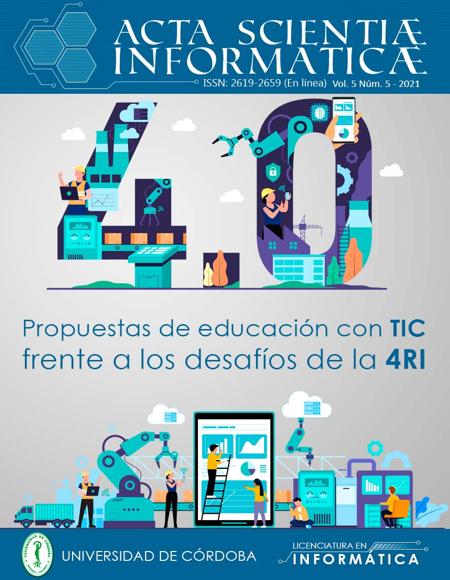Show authors biography
This article is a theoretical research on Learning Analytics seen from the perspective of various authors, as an integrative and inclusive tool in higher education.
For the construction of this investigative work, a deep search of documents was made; examining literatures of various types such as archives, magazines, among others; related to the subject and the year of publication, the relevance in the text, the keywords that frame the context and the deepening of the subject to be developed were taken into account.
Article visits 234 | PDF visits
Downloads
- R. C. Chick et al., “Using Technology to Maintain the Education of Residents During the COVID-19 Pandemic,” J. Surg. Educ., 2020, doi: 10.1016/j.jsurg.2020.03.018.
- E. E. C. Garay and M. A. Arrúa, “Impact of COVID-19 on university dropouts from business careers,” UNE, pp. 40–50, 2021.
- C. Roldán, “Predicción de la Deserción Estudiantil y Aplicación de Learning Analytics en la Escuela Ing. Cassaffousth Ing.,” vol. 21, no. 1, pp. 1–9, 2020.
- I. Hilliger et al., “Identifying needs for learning analytics adoption in Latin American universities: A mixed-methods approach,” Internet High. Educ., vol. 45, no. April 2019, p. 100726, 2020, doi: 10.1016/j.iheduc.2020.100726.
- A. Chiappe, L. P. Rodríguez, A. Chiappe, and L. P. Rodríguez, “Learning Analytics in 21st century education: a review,” Ens. Avaliação e Políticas Públicas em Educ., vol. 25, no. 97, pp. 971–991, Jun. 2017, doi: 10.1590/s0104-40362017002501211.
- R. Vuorikari et al., “Las Analíticas de Aprendizaje: evidencias e investigación sobre su uso Implicaciones para la política y la práctica,” Madrid, 2017. doi: 10.2791/955210.
- S. Dawson, S. Joksimovic, O. Poquet, and G. Siemens, “Increasing the impact of learning analytics,” ACM Int. Conf. Proceeding Ser., no. March, pp. 446–455, 2019, doi: 10.1145/3303772.3303784.
- M. A. Chatti, A. L. Dyckhoff, U. Schroeder, and H. Thüs, “A reference model for learning analytics,” Int. J. Technol. Enhanc. Learn., vol. 4, no. 5–6, pp. 318–331, 2018, doi: 10.1504/IJTEL.2012.051815.
- P. Rojas Castro, “Learning Analytics. Una Revisión de la Literatura,” Educ. y Educ., vol. 20, no. 1, pp. 106–128, Feb. 2017, doi: 10.5294/edu.2017.20.1.6.
- D. A. Filvà, M. A. Forment, F. J. García-Peñalvo, D. F. Escudero, and M. J. Casañ, “Learning analytics to assess students’ behavior with Scratch,” Futur. Gener. Comput. Syst., vol. 93, pp. 673–686, 2019, doi: 10.1016/j.future.2018.10.057.
- F. Simanca, “Sistema De Mejora Del Rendimiento Académico Mediante Learning Analytics,” p. 272, 2018.
- T. Martin and B. Sherin, “Learning Analytics and Computational Techniques for Detecting and Evaluating Patterns in Learning: An Introduction to the Special Issue,” J. Learn. Sci., vol. 22, no. 4, pp. 511–520, 2013, doi: 10.1080/10508406.2013.840466.
- A. G. Picciano, “The evolution of big data and learning analytics in american higher education,” J. Asynchronous Learn. Netw., vol. 16, no. 3, pp. 9–20, 2012, doi: 10.24059/olj.v16i3.267.
- G. Siemens, “Learning Analytics: The Emergence of a Discipline,” Am. Behav. Sci., vol. 57, no. 10, pp. 1380–1400, 2013, doi: 10.1177/0002764213498851.
- P. Long and G. Siemens, “Penetrating the Fog: Analytics Learning in Education,” Educause, vol. 29, no. 3, pp. 237–240, 2011, doi: 10.1177/0894318416647779.
- V. Kovanović et al., “Understand students’ self-Reflections through learning analytics,” ACM Int. Conf. Proceeding Ser., pp. 389–398, 2018, doi: 10.1145/3170358.3170374.
- Moodle, “Analytics,” 2020. https://docs.moodle.org/39/en/Analytics (accessed Oct. 07, 2020).
- L. Kart, “Big Data Industry Insights.” Gartner, p. 43, 2015, [Online]. Available: http://proyectos.andi.com.co/camarabpo/Webinar 2016/Big data industry insights- Gartner.pdf.
- K. Verbert, X. Ochoa, R. De Croon, R. A. Dourado, and T. De Laet, “Learning analytics dashboards: The past, the present and the future,” ACM Int. Conf. Proceeding Ser., pp. 35–40, 2020, doi: 10.1145/3375462.3375504.
- K. Lepenioti, A. Bousdekis, D. Apostolou, and G. Mentzas, “Prescriptive analytics: Literature review and research challenges,” Int. J. Inf. Manage., vol. 50, no. October 2018, pp. 57–70, 2020, doi: 10.1016/j.ijinfomgt.2019.04.003.
- Y. Liu, G. Mao, V. Leiva, S. Liu, and A. Tapia, “Diagnostic analytics for an autoregressive model under the skew-normal distribution,” Mathematics, vol. 8, no. 5, pp. 1–19, 2020, doi: 10.3390/MATH8050693.
- T. Doleck, D. J. Lemay, R. B. Basnet, and P. Bazelais, “Predictive analytics in education: a comparison of deep learning frameworks,” Educ. Inf. Technol., vol. 25, no. 3, pp. 1951–1963, 2020, doi: 10.1007/s10639-019-10068-4.
- C. Schumacher and D. Ifenthaler, “Features Students Really Expect From,” no. Celda, pp. 67–76, 2016.
- X. Zhang et al., “Accessibility within open educational resources and practices for disabled learners: a systematic literature review,” Smart Learn. Environ., vol. 2, pp. 1–19, 2020, doi: 10.1186/s40561-019-0113-2.
- K. Yamada et al., Integrating Multimodal Learning Analytics and Inclusive Learning Support Systems for People of All Ages, vol. 11577 LNCS. 2019.


